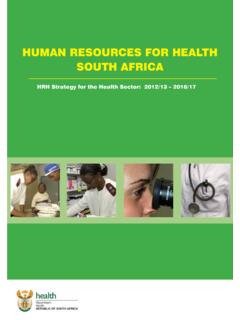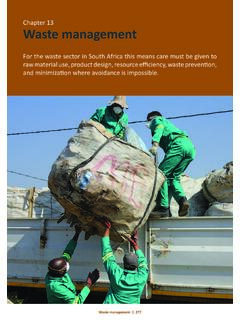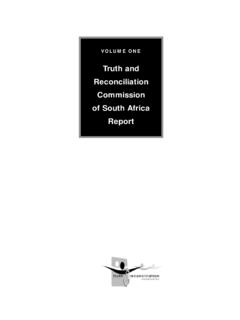Transcription of Framework for a Just Transition in South Africa
1 A Presidential Climate Commission Report Framework for a Just Transition in South Africa Draft for Discussion February 2022. About the Presidential Climate Commission The Presidential Climate Commission is a multi-stakeholder body established by the President of the Republic of South Africa to advise on the country's climate change response and pathways to a low-carbon climate-resilient economy and society. In building this society, we need to ensure decent work for all, social inclusion, and the eradication of poverty. We also need to protect those most vulnerable to climate change, including women, children, people with disabilities, the poor and the unemployed, and protect workers' jobs and livelihoods. The Presidential Climate Commission facilitates dialogue between social partners on these issues defining the type of society we want to achieve, and detailed pathways for how to get there.
2 2. About this Report This document presents a Framework for achieving a just Transition in South Africa . This Framework is the first building block towards reaching South Africa 's vision for just and equitable Transition towards climate resilience and zero-emissions development. The Framework sets out the vision, principles, planning elements and policy measures to achieve a just Transition in South Africa , as well as the outcomes to be achieved over the short, medium, and long-run. In so doing, the Framework aims to bring coherence and coordination to just Transition planning in South Africa . The Framework builds on a series of dialogues conducted by the Presidential Climate Commission in 2021 on issues pertinent to a just Transition (Figure 1). The Framework also stands of the shoulders of years of research in South Africa on just transitions, as well as prior consultation process, including those facilitated by NEDLAC and the National Planning Commission.
3 To watch the dialogues and read the related reports, visit This Framework must be tailored to those most impacted by the transitions that lie ahead. Accordingly, the Presidential Climate Commission is proceeding with a series of community consultations, along with broader outreach activities, to ensure the Framework is fit-for-purpose (Figure 1). Among other issues, this consultation will be used to discuss the relationship between climate risks and the just Transition , and how, specifically, and practically, the poor, women, and the youth can be empowered through this Transition ensuring that these perspectives are well situated in the Framework . The Framework is intended to be a living document, updated as circumstances change, and new learning takes place.
4 The Framework is also intended to be embraced by all social partners, adopted as a guide for all stakeholders for pressing forward with the just Transition . The document is not, however, a detailed implementation plan that will follow later. Figure 1: Process for Creating and Implementing the Just Transition Framework 3. Table of Contents About the Presidential Climate Commission .. 2. About this Report .. 3. 1. Introduction .. 5. 2. Purpose and Scope .. 6. 3. Structure .. 7. 4. Vision .. 7. 5. 8. 6. At-Risk Groups .. 9. Coal Value Chain .. 10. Auto Value Chain .. 10. Agriculture .. 11. Tourism .. 12. Phases and Timeframes for Impacts .. 13. Seizing Opportunities in the Different Phases of the Transition .. 16. 7. Planning Elements .. 17. Active Labour Markets and Human Resource Development.
5 17. Social Protection Measures .. 18. Industrial Development, Economic Diversification, and Innovation .. 19. Governance .. 20. Finance for a Just Transition .. 23. 8. Policy Measures for Immediate Effect .. 25. 9. Conclusion .. 33. 4. 1. Introduction The science is clear tackling climate change will require significant and unprecedented changes across all sectors of the economy. It will require innovations in the energy system, including a massive shift to low-carbon energy sources, as well as changes to the way we use our land and grow our food. The research is also clear making these changes, today, can create new and better jobs in South Africa , grow the economy, help protect the environment, and improve human health. South Africa is in one of the regions in the world that is most impacted by climate change, frequently experiencing droughts, floods, and other extreme weather events associated with global warming.
6 These events have already caused enormous damage to infrastructure and livelihoods, and displaced thousands of people. South Africa is also one of the most vulnerable countries to Transition risk . the changed forced upon people and the economy as a result of changes in the global demand for goods and services, changes in technology, and changes in global policy. It is in South Africa 's national interests to join the world in combating the rapidly accelerating climate crisis, in accordance with our national circumstances and development priorities. Addressing climate change means strengthening adaptation measures to improve the resilience of individuals, communities, and human settlements to extreme weather events. It also requires sharp reductions in greenhouse gas emissions the pollutants that drive climate change.
7 Climate change and the related economic and social impacts have already begun to affect South Africa 's economy and society. Accordingly, the just Transition is about seizing opportunities and managing risks, actively, with an overarching focus on improving the lives and livelihoods of South Africans, particularly those most impacted. Seizing Opportunities There are substantial opportunities in a just and equitable Transition towards climate resilient and zero-emissions development. Renewable energy production will make electricity cheaper and more dependable and will create new manufacturing and maintenance jobs. This will have positive knock-on effects on energy-dependent economic sectors, including mining, cement, and manufacturing. Investments in electric vehicles and hydrogen will equip South Africa to meet the global clean energy future.
8 The clean energy Transition will also open new markets for the supply of clean energy minerals, like platinum, vanadium, cobalt, copper, manganese, and lithium. Climate-smart agriculture could create better yields and more resilient crops, improving the lives and livelihoods of farmers. Above all, the just trust Transition can create a more jobs-rich, equitable, and inclusive economy. 5. Managing Risks South Africa 's reliance on coal and other fossil fuels had created a carbon-intensive economy. As the world decarbonizes more aggressively, there are risks that South Africa 's international exports will be penalized and investments in carbon-intensive industries restricted. Reducing greenhouse gas emissions in a structured way and growing new green industries is crucial to building the country's medium- and long- term economic competitiveness and jobs.
9 Improving the Lives and Livelihoods of South Africans: Keeping People at the Centre of Decision-Making Realising the potential benefits of the just Transition requires strategies to deal constructively with the unavoidable burdens arising from the disruption caused by the Transition from fossil fuels and other technologies and commodities being phased out, as well as the costs of climate change, already borne disproportionately by the poor. Accordingly, a just Transition responds to the following imperatives: How do we empower people and communities in the Transition to a low-emissions economy? How do we ensure that the most impacted do not get left behind? How do we support the goals of social inclusion and decent work for all? How do we continue to solve South Africa 's triple challenges (inequality, poverty, and unemployment).
10 Based on the roadmap laid out in the National Development Plan? This Framework begins to respond to these imperatives. 2. Purpose and Scope This document presents a Framework for achieving a just Transition in South Africa in essence, a practical introduction for giving effect to the just Transition in the country. The Framework is positioned at the intersection of South Africa 's broader efforts to redesign the economy to the benefit of most citizens ( , addressing the triple challenges), as well as the domestic response to climate change ( , improving resilience and making substantial cuts to greenhouse gas emissions). Accordingly, the Framework does not deal with climate mitigation and adaptation policies per se, but rather with managing the social consequences and economic upside of those policies, while putting human development concerns at the centre of decision- making.





